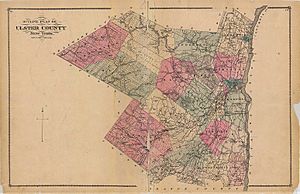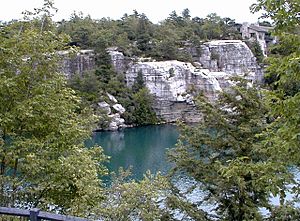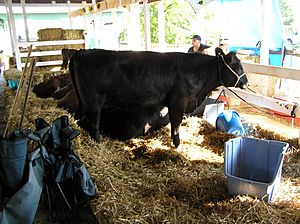Ulster County, New York facts for kids
Quick facts for kids
Ulster County
|
|||
|---|---|---|---|
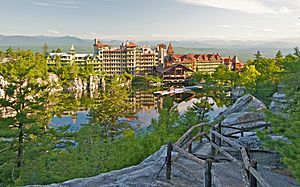
|
|||
|
|||
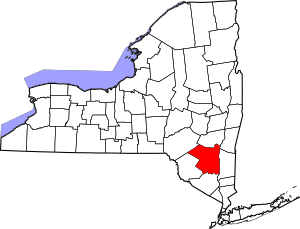
Location within the U.S. state of New York
|
|||
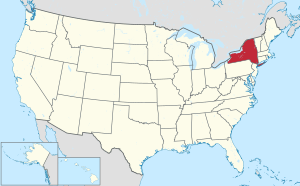 New York's location within the U.S. |
|||
| Country | |||
| State | |||
| Founded | November 1, 1683 | ||
| Named for | Prince James, Duke of York and Albany and Earl of Ulster | ||
| Seat | Kingston | ||
| Largest city | Kingston | ||
| Area | |||
| • Total | 1,161 sq mi (3,010 km2) | ||
| • Land | 1,124 sq mi (2,910 km2) | ||
| • Water | 37 sq mi (100 km2) 3.1% | ||
| Population
(2020)
|
|||
| • Total | 181,851 |
||
| • Density | 160/sq mi (60/km2) | ||
| Time zone | UTC−5 (Eastern) | ||
| • Summer (DST) | UTC−4 (EDT) | ||
| Congressional districts | 18th, 19th | ||
Ulster County is a county in the U.S. state of New York. It is situated along the Hudson River. As of the 2020 census, the population was 181,851. The county seat is Kingston. The county is named after the Irish province of Ulster. The county is part of the Hudson Valley region of the state.
Contents
History
Founding and formation
When part of the New Netherland colony, Dutch traders first called the area of present-day Ulster County "Esopus", a name borrowed for convenience from a locality on the opposite side of the Hudson. "Esopus" meant "land of flowing water and high banks," or "small brook." There is also a town named Esopus located within Ulster County.
The local Lenape indigenous people called themselves Waranawanka, but soon came to be known to the Dutch as the "Esopus Indians" because they were encountered around the settlement known as Esopus. In 1652, Thomas Chambers, a freeholder from the Manor of Rensselaerswyck, purchased land at Esopus. He and several others actually settled and began farming by June 1653. The settlements grew into the village of Wiltwijck, which the English later named Kingston. In 1683, the Duke of York created 12 counties in his province, one of which was Ulster County, named after Prince James, Duke of York (later King James II of England) whose subsidiary titles included Earl of Ulster. Its boundaries at that time included the present Sullivan County and parts of the present Delaware, Orange, and Greene counties.
In 1777, the first state capital of the independent New York State was established at Kingston. The official records of Ulster County were removed to safety to a stone house in Kerhonkson when it became evident that the British would burn Kingston.
In 1797, parts of Otsego and Ulster Counties were split off to create Delaware County.
In 1798, Ulster County's southernmost towns were moved into Orange County to compensate Orange for breaking away its southernmost part to form Rockland County.
In 1800, portions of Albany and Ulster Counties were split off to create Greene County.
In 1809, Sullivan County was split off from Ulster County.
Civil War
During the American Civil War, volunteers were recruited from the county and formed the majority of the following regiments:
- 80th New York Volunteer Infantry Regiment
- 120th New York Volunteer Infantry
- 156th New York Volunteer Infantry
Other regiments with at least one company from the county included:
- 1st Battalion New York Volunteer Sharpshooters
- 1st New York Volunteer Engineer Regiment
- 7th Regiment New York Volunteer Cavalry
- 7th New York Veteran Infantry Regiment
- 15th Regiment New York Volunteer Cavalry
- 20th New York Volunteer Infantry Regiment
- 25th Regiment New York Volunteer Cavalry
- 25th New York Volunteer Infantry Regiment
- 56th New York Volunteer Infantry
- 65th New York Volunteer Infantry
- 71st New York Infantry
- 102nd New York Volunteer Infantry
- 132nd New York Volunteer Infantry Regiment
- 168th New York Volunteer Infantry
- 176th New York Volunteer Infantry
- 178th New York Volunteer Infantry Regiment
- 192nd New York Volunteer Infantry
Twentieth century
The Lake Mohonk Mountain House on Shawangunk Ridge was designated a National Historic Landmark in 1986.
Geography
According to the U.S. Census Bureau, the county has an area of 1,161 square miles (3,010 km2), of which 1,124 square miles (2,910 km2) is land and 37 square miles (96 km2) (3.1%) is water.
Ulster County is in southeastern New York State, south of Albany, immediately west of the Hudson River. Much of it is within the Catskill Mountains and the Shawangunk Ridge. Ulster County has Minnewaska State Park Preserve, Mohonk Preserve, Sundown State Park, VerNooykill State Forest, Witches Hole State Forest, and Shawangunk Ridge State Forest. The Sam's Point section of Minnewaska includes rare dwarf pine trees and Verkeerder Kill falls.
The county's highest point is Slide Mountain, at approximately 4,180 feet (1,270 m) above sea level. The lowest point is sea level along the Hudson River.
Adjacent counties
- Greene County — north
- Columbia County — northeast
- Dutchess County — southeast
- Orange County — south
- Sullivan County — southwest
- Delaware County — northwest
National protected area
- Shawangunk Grasslands National Wildlife Refuge
Demographics
| Historical population | |||
|---|---|---|---|
| Census | Pop. | %± | |
| 1790 | 29,370 | — | |
| 1800 | 24,855 | −15.4% | |
| 1810 | 26,576 | 6.9% | |
| 1820 | 30,934 | 16.4% | |
| 1830 | 36,550 | 18.2% | |
| 1840 | 45,822 | 25.4% | |
| 1850 | 59,384 | 29.6% | |
| 1860 | 76,381 | 28.6% | |
| 1870 | 84,075 | 10.1% | |
| 1880 | 85,838 | 2.1% | |
| 1890 | 87,062 | 1.4% | |
| 1900 | 88,422 | 1.6% | |
| 1910 | 91,769 | 3.8% | |
| 1920 | 74,979 | −18.3% | |
| 1930 | 80,155 | 6.9% | |
| 1940 | 87,017 | 8.6% | |
| 1950 | 92,621 | 6.4% | |
| 1960 | 118,804 | 28.3% | |
| 1970 | 141,241 | 18.9% | |
| 1980 | 158,158 | 12.0% | |
| 1990 | 165,304 | 4.5% | |
| 2000 | 177,749 | 7.5% | |
| 2010 | 182,493 | 2.7% | |
| 2020 | 181,851 | −0.4% | |
| U.S. Decennial Census 1790–1960 1900–1990 1990–2000 2010–2020 |
|||
As of the census of 2010, the county had 181,440 people, 67,499 households, and 43,536 families. The population density was 158 inhabitants per square mile (61/km2). There were 77,656 housing units at an average density of 69 units per square mile (27/km2). The county's racial makeup, as of 2008, was 83.2% white, 6.50% black or African American, 0.3% Native American, 1.7% Asian, 0.03% Pacific Islander, 2.15% from other races, and 1.70% from two or more races. 7.6% of the population were Hispanic or Latino of any race. 19.2% were of Italian, 16.8% Irish, 15.5% German, 6.8% English, and 4.7% American ancestry according to Census 2000. 90.3% spoke English, 4.5% Spanish, 1.2% Italian, and 1.0% German as their first language.
There were 67,499 households, of which 30.70% had children under age 18 living with them, 49.20% were married couples living together, 10.90% had a female householder with no husband present, and 35.50% were non-families. Of all households, 27.90% were made up of individuals, and 10.20% had someone living alone who was 65 years of age or older. The average household size was 2.47 and the average family size was 3.03.
23.50% of the county's population was under age 18, 8.70% was from age 18 to 24, 29.70% was from age 25 to 44, 24.70% was from age 45 to 64, and 13.30% was age 65 or older. The median age was 38 years. For every 100 females, there were 99.10 males. For every 100 females age 18 and over, there were 96.60 males.
The county's median household income was $42,551, and the median family income was $51,708. Males had a median income of $36,808 versus $27,086 for females. The per capita income for the county was $20,846. About 7.20% of families and 11.40% of the population were below the poverty line, including 13.00% of those under age 18 and 8.70% of those age 65 or over.
2020 Census
As of the 2020 census the population of Ulster County is 181,851. The population density was 158 inhabitants per square mile (61/km2). The county's racial makeup, as of 2020, was 75.16% non-Hispanic white, 5.8% black or African American, 0.2% Native American, 2.1% Asian, 0.02% Pacific Islander, 5.4% from other races or from two or more races. 11.61% of the population were Hispanic or Latino of any race
| Race | Num. | Perc. |
|---|---|---|
| White (NH) | 136,695 | 75.16% |
| Black or African American (NH) | 10,152 | 5.8% |
| Native American (NH) | 306 | 0.2% |
| Asian (NH) | 3,778 | 2.1% |
| Pacific Islander (NH) | 45 | 0.02% |
| Other/Mixed (NH) | 9,756 | 5.4% |
| Hispanic or Latino | 21,119 | 11.61% |
Recreation
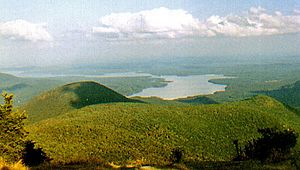
Ulster County contains a large part of Catskill Park and the Catskill Forest Preserve. The former Delaware and Hudson Canal brought Pennsylvania coal to Kingston on the Hudson. Former Orleans band member John Hall served in the Ulster County legislature before moving to the 19th Congressional District to run for Congress.
Ulster County has continued to be a popular vacation destination for many decades. The county is home to many outdoor landscapes, including the Catskill Mountains, the Hudson River, Minnewaska State Park, Catskill Park, Shawangunk Mountains and the Shawangunk Ridge. Each offers various recreation opportunities, including hiking, bicycling, skiing, horseback riding, kayaking, rock climbing, hunting and fishing.
The county also includes more than 40 miles (64 km) of rail trails along the Hudson Valley Rail Trail, Wallkill Valley Rail Trail, and O&W Rail Trail. The Walkway Over the Hudson, the world's longest pedestrian and bicycle bridge which spans the Hudson River, is connected within Ulster County trails.
Ulster County has also played a role in some significant moments in U.S. history. The Senate House State Historic Site in Kingston, New York, is where, in early 1777, American colonists met to ratify the New York Constitution.
The Ulster County Fair has been held in New Paltz for many years and is promoted as "The Best Six Days of Summer". County run recreation areas include the Ulster County Pool in New Paltz and the Ulster Landing Park in Saugerties.
Since 2016, Kingston Stockade FC, a semi-professional soccer team that plays in the National Premier Soccer League (NPSL), has been based in Kingston and plays its home matches at Dietz Stadium.
Also since 2015, the Saugerties Stallions, a collegiate summer baseball league team that plays in the Perfect Game Collegiate Baseball League (PGCBL), have been based in Saugerties and play their home games at Cantine Field. The Stallions won the 2021 PGCBL Championship.
Transportation
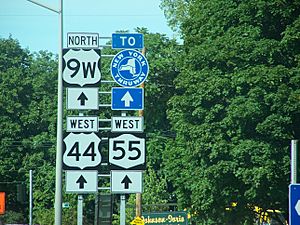
Public transportation in Ulster County is provided by Trailways of New York to and from New York City and Albany, and along Routes 28 and 32, by Ulster County Area Transit on major state and U.S. road corridors in the county.
Major roadways
The New York State Thruway (I-87) runs north–south through the county, carrying traffic between New York City and Albany and its surroundings. NY 55, NY 52, and NY 28 are all major east–west highways that run through the county, and US 209, US 9W, and NY 32 are major north–south highways.
Communities
| Ulster County, New York |
|---|
|
|
City
- Kingston (county seat)
Towns
Villages
Census-designated places
- Accord
- Clintondale
- Cragsmoor
- East Kingston
- Gardiner
- Glasco
- High Falls
- Highland
- Hillside
- Hurley
- Kerhonkson
- Lake Katrine
- Lincoln Park
- Malden-on-Hudson
- Marlboro
- Milton
- Napanoch
- Phoenicia
- Pine Hill
- Plattekill
- Port Ewen
- Rifton
- Rosendale
- Ruby
- Saugerties South
- Shokan
- Stone Ridge
- Tillson
- Walker Valley
- Wallkill
- Watchtower
- West Hurley
- Woodstock
- Zena
Hamlets
- Bearsville
- Big Indian
- Bloomington
- Boiceville
- Brown's Station
- Centerville
- Chichester
- Cottekill
- Kaatsbaan
- Krumville
- Lew Beach
- Modena
- Mt. Pleasant
- Mt. Tremper
- Olivebridge
- Oliverea
- Palentown
- Samsonville
- Seager
- Shady
- Spring Glen
- Sundown
- Tabasco
- West Park
- West Saugerties
- West Shokan
- Willow
Education
School districts include:
- Ellenville Central School District
- Fallsburg Central School District
- Highland Central School District
- Kingston City School District
- Livingston Manor Central School District
- Margaretville Central School District
- Marlboro Central School District
- New Paltz Central School District
- Onteora Central School District
- Pine Bush Central School District
- Rondout Valley Central School District
- Saugerties Central School District
- Tri-Valley Central School District
- Valley Central School District (Montgomery)
- Wallkill Central School District
See also
 In Spanish: Condado de Ulster para niños
In Spanish: Condado de Ulster para niños




